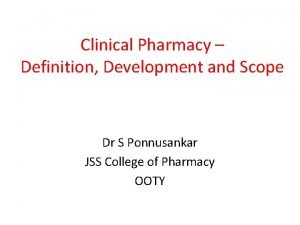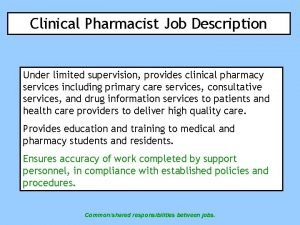Maimonides Medical Impact of Center a Clinical Pharmacist

- Slides: 1

Maimonides Medical Impact of Center a Clinical Pharmacist on a Trauma / General Surgery Service at a Level 1 Trauma Center Joshua Beckhusen, Pharm. D; Jason Brady, Pharm. D, BCPS; Health Walden, MD; Ronald Simon, MD; Patricia Caruso, Pharm. D, BCPS; Antonios Likourezos, MA, MPH Maimonides Medical Center, Brooklyn, NY Background • The role of a trauma pharmacist is not well established. 1, 2 • Pharmacists are not present on the trauma/general surgery service at our institution and instead are unit-based. • Trauma patients experience twice as many adverse drug events (ADE) versus non-trauma patients. Trauma patients that experienced ADEs were associated with significantly prolonged hospital stays and additional costs. 3 • Implementation of a pharmacist on a trauma service resulted in significant cost savings and prevention of ADE. 1 • Inpatient medication therapy management is needed for trauma patients given their fragility and medical needs. 4 Results Objectives • To assess a clinical pharmacist’s impact on a trauma/general surgery service through documentation of interventions. Hypothesis • A clinical pharmacist on a trauma/general surgery service increases the number of interventions. Methodology *Other includes monitoring, drug information consultation, ADR reporting, IV/PO conversion, patient education, and clarification of allergy/intolerance. Study Design • Institutional Review Board approved retrospective chart review • Comparison of team-based and unit-based pharmacy services • Team-based pharmacist assessed patients, participated in rounds, made interventions, and was readily consulted Patient Demographics Mean age, years (range) White, % Female, % Fall, % Motor Vehicle Collision, % Other, % Primary Outcome • Quantify and categorize interventions accepted by team Secondary Outcomes • Potential cost savings • Prevention of potential adverse drug events Inclusion Criteria • Patients > 18 years admitted to trauma/general surgery service • Intervention documented in electronic medical record Patient demographics • Interventions (category, type, drug class, description) • Prevention of ADEs (description, associated costs) Team-based Care (N=127) 80 (59 -93) 71 (19 -101) 71. 4 68. 5 55. 1 62. 3 14. 1 14. 3 23. 6 Conclusion Data Collected • Unit-based Care (N=7) • • Implementing a pharmacist on a trauma/general surgery service increased the number of documented interventions Interventions were associated with potential cost savings and the prevention of potential ADEs The trauma/general surgery rotation is now offered to pharmacy residents A clinical pharmacist is needed on the trauma/general surgery service to continue meeting pharmacy needs of these patients and to participate in research • • Twenty potential adverse drug events were prevented Potential $59, 534 in cost savings over 2 months ($357, 204/year) References 1. 2. 3. 4. Hamblin S, Rumbaugh K, Miller R. Prevention of adverse drug events and cost savings associated with Pharm. D interventions in an academic level 1 trauma center: an evidence-based approach. J Trauma Acute Care Surg. 2012; 73(6): 1484 -90. Patanwala A, Hays D. Pharmacist’s activities on a trauma response team in the emergency department. Am J Health-Syst Pharm. 2010; 67: 1536 -8. Lazarus HM, Fox J, Evans S, et al. Adverse drug events in trauma patients. J Trauma. 2003; 54: 337 -43. Farinde A. Benefits of medication therapy management in trauma care. Journal of Trauma Nursing. 2014; 21(5): 228. Disclosures The authors of this presentation have no possible financial disclosures or personal relationships with commercial entities that may have a direct or indirect interest in the subject matter of this presentation.

